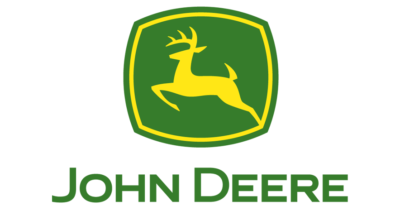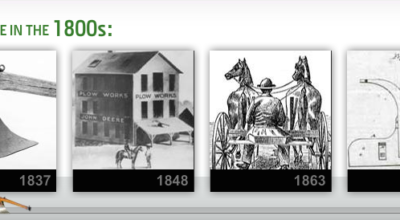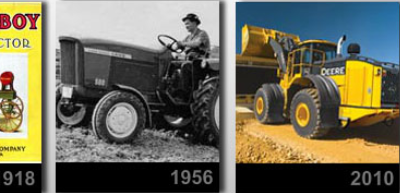From the moment John Deere and Company was founded in 1868 and John Deere himself said “I will never put my name on a product that doesn’t have in it the best that is in me,” the company has stuck to its core values of integrity, quality, commitment and innovation, led by just a handful of captains.
Let’s take a walk down memory lane and look at a brief history of John Deere leaders, what eras they led, and some of the John Deere products that were born during their tenure.
1837-1886 John Deere Founder and President
John Deere is the man that started it all. In 1837, he created his first plow using a broken saw blade and by 1841, Deere was producing 100 similar plows annually. After a brief partnership with Leonard Andrus, Deere moved his business to Moline, Illinois, where he created about 1,600 plows a year among other tools to compliment the steel plow. In 1858, he transferred the majority of leadership to his son, Charles, but retained title of president of the company. Take a look at this post for a more complete biography about John Deere.
1886-1907 Charles Deere President
Charles Deere was John’s second son, and was not expected to take over the family business until his older brother tragically passed in 1848. Charles started as a book keeper before moving to the marketing and sales side of the business, eventually taking over the company at just 21 years of age, largely due to his sharp business skills. In 1869, Charles established the company’s first branch house in Kansas City, before establishing four more branch houses by 1889. The various branch houses provided information from the field and led to the production of more than 300 models of plows by 1907.
1907-1936 William Butterworth President/Chairman
Butterworth served as the treasurer of Deere and Company from 1897-1907, before taking over as president following Charles Deere’s death. In 1910, Butterworth guided the unifying process of 11 factories and 25 sales organizations into one consolidated entity, followed by the emergence of the modern Deere and Company in 1912. The combine harvester, an agricultural milestone at the time, was born under Butterworth’s rule, shortly followed by the purchase of Waterloo Gasoline Engines, which led to the company’s first product in the tractor market in 1918.
1928-1955 Charles Deere Wiman President
Wiman took over as President in 1928 after working as vice-president since 1924. He placed his focus on new product development, and in 1934, introduced the famous Model “A” tractor. Just a year later, the Model “B” was introduced, and remained in production until 1952.
1955-1982 William Hewitt President/Chairman
In 1955, Hewitt took over as the company’s president, a time when Deere took its first steps towards becoming a global corporation. By 1970, Hewitt helped the company establish a presence in Argentina, Venezuela, France, Spain, Great Britain and Western Europe, Australia, Japan, South Africa, China, and the Middle East. In addition to global expansion efforts, Hewitt brought four and six-cylinder tractors into the Deere line. After deciding the company’s headquarters should remain in Moline, Hewitt was the mind behind selecting world renowned Finnish architect Eero Saarinen to design the new home of John Deere and Company.
1982-1990 Robert Hanson Chairman and CEO
When Hanson took over in the early 80s, the agricultural machinery cycle was at a very low point. However, under his guidance, the company focused on looking within to reduce costs. In the ensuing years, Deere sales soared, and the challenges had been weathered. In 1985, the company entered the health care market with the formation of John Deere Health Care, before Hanson retired in 1990.
1990-2000 Hans Becherer Chairman and CEO
Bechere took over in 1990 and quickly established a focus on “genuine value,” building upon continuous improvement and global growth. Under his control, Deere’s lawn-and-grounds-care-equipment operations became its own operating division. Following a 1991 purchase of SABO, a European maker of mowers, lawn-and-garden sales topped $1 billion for the first time. The company also expanded globally once again, this time into China, India, South America and Russia. Later in the 90s, Deere began a relationship with the PGA Tour, sponsoring the annual John Deere Classic and becoming the official golf course equipment supplier of the Tour’s Tournament Players Club (TPC) courses. In 1997, the John Deere Pavilion opened in Moline, making Deere a new player in the tourist industry.
2000-2009 Robert W. Lane Chairman and CEO
Under Lane’s leadership, Deere has experienced record growth and success, surpassing $2 billion in 2008, more than doubling revenues from 2000. Also turning a focus towards global expansion, Lane was behind several investments, including Brazil, India, and China. Lane reworked and modernized Deere’s traditional factories, while also significantly upgrading dealer organizations to better support customer needs.
Each of these leaders are responsible for a pretty large chunk of John Deere’s history, from its origin to present day. Hopefully this trip back to the past shed some light on the transformation of John Deere and Company from steel plows to cutting-edge agricultural technology.
If you enjoyed this post and would like to see more like it, feel free to connect with us on Facebook!


